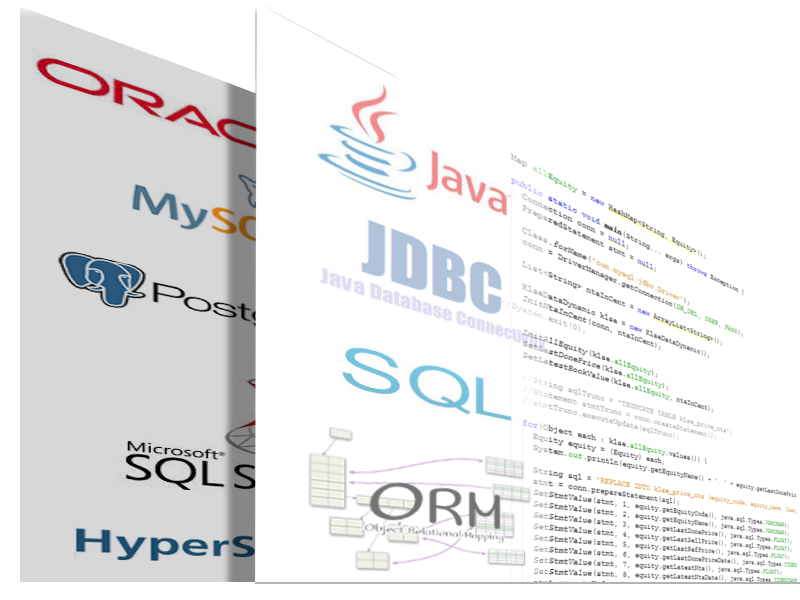StORMi maps Java POJO into relational databases. StORMi is the only true ORM that is able to map all OO concept into a relational database.
- MySQL
- MariaDB
- Postgres
- Oracle
StORMi supports mapping the following Java OOP concepts:
- Class (maps into a table)
- Properties (maps class properties into database fields for all primitive datatypes)
- Class Properties (maps complex datatypes of type class, in OOP also known as a member of)
- Inheritance (maps the inheritance relationship of a class with the inherited class)
- Abstract Class (places the properties of an abstract class into a concrete class)
- Polymorphism (enable a member of class type to behave polymorphically)
- Array of Objects (supports handling of array of objects)
StORMi supports the following database operations:
- DDL Creation (generate DDL to create tables, columns for the defined class in Java)
- Persistence (when a Java POJO class is persisted, StORMi will handle all the underlying intricancies)
- Deletion (when deleting a class, StORMi can also delete its related class when configured to do so)
- Updating (like Persistence and Deletion, many complex class relationship is being manage by StORMi)
- No SQL hence can be easily ported to any SQL database, DDL/DML can be done through java methods
- Allow full enterprise team to use standard OOP as the universal design model
- Never redesign your data model again with StORMi standard, consistent and reusable model
- Allows team to have common understanding of a single design principal and concept
- No duplication of enterprise information
- Unlimited standardise scaling capabilities for all your enterprise information system
// anything that extends Clasz will be map into the database
public class Addr extends Clasz {
@ReflectField(type=FieldType.STRING, size=32, displayPosition=5)
public static String Addr1;
@ReflectField(type=FieldType.STRING, size=32, displayPosition=10)
public static String Addr2;
@ReflectField(type=FieldType.STRING, size=32, displayPosition=15)
public static String Addr3;
@ReflectField(type=FieldType.STRING, size=8, displayPosition=20)
public static String PostalCode;
@ReflectField(type=FieldType.OBJECT, deleteAsMember=false,
clasz=biz.shujutech.bznes.Country.class, displayPosition=35, prefetch=true, lookup=true)
public static String Country;
@ReflectField(type=FieldType.OBJECT, deleteAsMember=false,
clasz=biz.shujutech.bznes.State.class, displayPosition=40, prefetch=true, lookup=true)
public static String State;
@ReflectField(type=FieldType.OBJECT, deleteAsMember=false,
clasz=biz.shujutech.bznes.City.class, displayPosition=45, prefetch=true, lookup=true)
public static String City;
} Person employee = (Person) ObjectBase.CreateObject(conn, Person.class);
employee.setName("Ken Miria");
employee.setBirthDate(new DateTime());
employee.setGender(Gender.Male);
employee.setNationality(Country.UnitedStates);
employee.setMaritalStatus(Marital.Married);
company.addEmployee(conn, employee);
ObjectBase.PersistCommit(conn, company); // create the object to delete and set a unique search criteria
Person person = (Person) objectDb.createObject(Person.class);
person.setName("Edward Yourdon");
if (person.populate(conn) == true) {
if (person.deleteCommit(conn)) {
App.logInfo("Deleted person Edward Yourdon");
} else {
throw new Hinderance("Fail to delete person Edward Yourdon");
}
}-
Install Postgres and create a database name 'stormi' using 'postgres' user and 'abc1234' password.
-
Install Java and Maven if you do not have them.
-
Download StORMi soruce code from github and extract them to your install directory.
-
Build StORMi by going into the installed directory and run
mvn install- Go into the example directory and run
mvn clean compile assembly:single- In the example/target directory, copy stormi.proprties into the target directory
cp ../stormi.properties .- Run the example application with
java -jar example-1.0-SNAPSHOT-jar-with-dependencies.jar- You will get the follwoing output
18Jun2021 22:56:14 INFO Log level is at: DEBG
18Jun2021 22:56:14 INFO Working directory: C:\Shujutech\StORMi-main\example\target
18Jun2021 22:56:14 INFO Found property file at: C:\Shujutech\StORMi-main\example\target\stormi.properties
18Jun2021 22:56:14 INFO Configuration from: C:\Shujutech\StORMi-main\example\target\stormi.properties
18Jun2021 22:56:14 INFO Log file: C:\Users\Admin\AppData\Local\Temp\\App.202106.log
18Jun2021 22:56:14 INFO Log on console: true
18Jun2021 22:56:14 INFO Log next switch at: 2021-07-01T00:00:00.244+08:00
18Jun2021 22:56:14 INFO Maximum thread: 16
18Jun2021 22:56:14 COFG OS name: Windows 10
18Jun2021 22:56:14 COFG OS architecture: amd64
18Jun2021 22:56:14 COFG OS version: 10.0
18Jun2021 22:56:14 COFG Java classpath: example-1.0-SNAPSHOT-jar-with-dependencies.jar
18Jun2021 22:56:14 INFO Total db connection available for threading: 2
18Jun2021 22:56:14 COFG Jdbc, connecting with url = jdbc:postgresql://localhost:5432/stormi
18Jun2021 22:56:14 COFG Jdbc, connecting with user = postgres
18Jun2021 22:56:14 COFG Jdbc, connecting with password = *********
18Jun2021 22:56:14 COFG Jdbc, connecting with init conn = 2
18Jun2021 22:56:14 COFG Jdbc, connecting with max conn = 32
18Jun2021 22:56:14 COFG Jdbc, connecting with time out= 30
18Jun2021 22:56:15 WARN [ConnectionPool] Getting jdbc connection, available free connection to get from: 2
18Jun2021 22:56:15 INFO [Clasz] Creating table for class: 'LeaveForm'
18Jun2021 22:56:15 INFO [Simple] Successfully save leave form into the database!
18Jun2021 22:56:15 DEBG [ConnectionPool] Released jdbc connection, total free connection: 2- Check your database for the created tables
To use StORMi without maven, copy the jar file in the 'relase' directory into your java project library.
If you're using maven, dowload the release directory and run the following maven command:
mvn install:install-file -Dfile=./StORMi-1.0-SNAPSHOT.jar -DpomFile=./pom.xmlAfter installing StORMi into your maven repository, use the following pom dependency in you maven project:
<dependency>
<groupId>biz.shujutech</groupId>
<artifactId>StORMi</artifactId>
<version>1.0-SNAPSHOT</version>
</dependency>
To try out StORMi, go to the 'example' directory and compile 'Simple.java' and execute it. To compile with IDE (e.g. eclipse or netbeans) you can import the maven project.
Before executing the 'example', create a database (either postgresql or mysql) and configure it's jdbc properties in the file 'stormi.properties' (jdbcUser, jdbcPassword, jdbcUrl). The default configured is (schema: stormi, login: postgres, password: abc1234)
For any further support, please contact me at [email protected]
